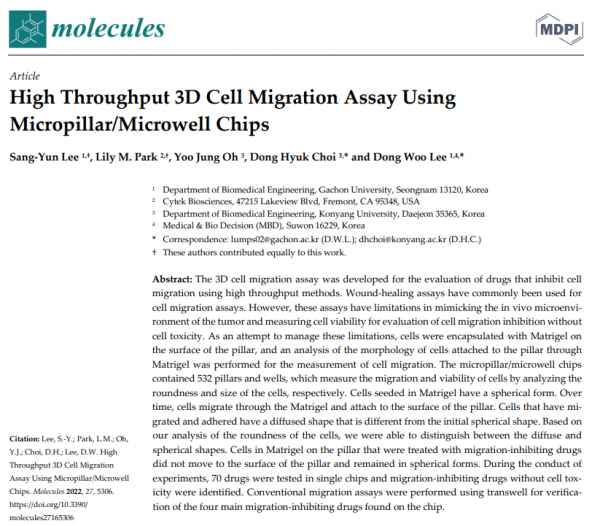논문 2022, Molecules, High Throughput 3D Cell Migration Assay Using Microp…
페이지 정보

본문
Abstract:
The 3D cell migration assay was developed for the evaluation of drugs that inhibit cell migration using high throughput methods. Wound-healing assays have commonly been used for cell migration assays. However, these assays have limitations in mimicking the in vivo microenvironment of the tumor and measuring cell viability for evaluation of cell migration inhibition without cell toxicity. As an attempt to manage these limitations, cells were encapsulated with Matrigel on the surface of the pillar, and an analysis of the morphology of cells attached to the pillar through Matrigel was performed for the measurement of cell migration. The micropillar/microwell chips contained 532 pillars and wells, which measure the migration and viability of cells by analyzing the roundness and size of the cells, respectively. Cells seeded in Matrigel have a spherical form. Over time, cells migrate through the Matrigel and attach to the surface of the pillar. Cells that have migrated and adhered have a diffused shape that is different from the initial spherical shape. Based on our analysis of the roundness of the cells, we were able to distinguish between the diffuse and spherical shapes. Cells in Matrigel on the pillar that were treated with migration-inhibiting drugs did not move to the surface of the pillar and remained in spherical forms. During the conduct of experiments, 70 drugs were tested in single chips and migration-inhibiting drugs without cell toxicity were identified. Conventional migration assays were performed using transwell for verification of the four main migration-inhibiting drugs found on the chip.
The 3D cell migration assay was developed for the evaluation of drugs that inhibit cell migration using high throughput methods. Wound-healing assays have commonly been used for cell migration assays. However, these assays have limitations in mimicking the in vivo microenvironment of the tumor and measuring cell viability for evaluation of cell migration inhibition without cell toxicity. As an attempt to manage these limitations, cells were encapsulated with Matrigel on the surface of the pillar, and an analysis of the morphology of cells attached to the pillar through Matrigel was performed for the measurement of cell migration. The micropillar/microwell chips contained 532 pillars and wells, which measure the migration and viability of cells by analyzing the roundness and size of the cells, respectively. Cells seeded in Matrigel have a spherical form. Over time, cells migrate through the Matrigel and attach to the surface of the pillar. Cells that have migrated and adhered have a diffused shape that is different from the initial spherical shape. Based on our analysis of the roundness of the cells, we were able to distinguish between the diffuse and spherical shapes. Cells in Matrigel on the pillar that were treated with migration-inhibiting drugs did not move to the surface of the pillar and remained in spherical forms. During the conduct of experiments, 70 drugs were tested in single chips and migration-inhibiting drugs without cell toxicity were identified. Conventional migration assays were performed using transwell for verification of the four main migration-inhibiting drugs found on the chip.
관련링크
- 이전글
 2021, PLOS ONE, High-dose drug heat map analysis for drug safety and efficacy in multi-spheroid brain normal cells and GBM patient-derived cells 21.12.14
2021, PLOS ONE, High-dose drug heat map analysis for drug safety and efficacy in multi-spheroid brain normal cells and GBM patient-derived cells 21.12.14 - 다음글
 2022, Analytical chemistry, Cell Proliferation Receptor-Enhanced 3D High-Throughput Screening Model for Optimized Drug Efficacy Evaluation in Breast Cancer Cells 22.08.23
2022, Analytical chemistry, Cell Proliferation Receptor-Enhanced 3D High-Throughput Screening Model for Optimized Drug Efficacy Evaluation in Breast Cancer Cells 22.08.23

